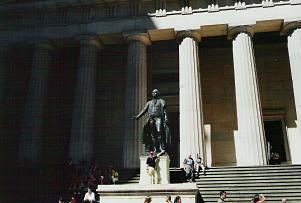Federal Hall
|
|

Federal Hall, once located at 26 Wall Street in New York City, was the first capitol building of the United States. The building was demolished in the 19th century and replaced by the current structure, the first United States Customs House. The building is now operated by the National Park Service as the Federal Hall National Memorial, a museum that commemorates the earlier structure.
| Contents |
Historical building
Federal_Hall_NYC1.jpg
The original structure on the site was built as New York's City Hall in 1700. In 1735, John Peter Zenger, an American newspaper publisher, was arrested for committing libel against the British royal governor and was imprisoned and tried there. His acquittal on the grounds that the material he had printed was true established the freedom of the press as it was later defined in the Bill of Rights.
In October, 1765, delegates from nine of the 13 colonies met in response to the levying of the Stamp Act by King George III. Drawn together for the first time in organized opposition to British policy, the attendees drafted a message to King George III, the House of Lords, and the House of Commons, claiming entitlement to the same rights as the residents of Britain and protesting the colonies' "taxation without representation."
Remodeled and enlarged following the American Revolution, the building was renamed Federal Hall when it became the first Capitol of the United States in 1789. The first United States Congress met there on March 4, 1789, to establish the new federal government under the Constitution, and the first thing they did was count the votes that elected George Washington as the first President of the United States. He was inaugurated in front of the building on April 30.
Not long after the new federal Constitution was ratified, many Americans began to express their concern for its limited protection of individual liberties. Ten amendments to the Constitution were drafted, and on September 25, 1789, the Bill of Rights was adopted in Federal Hall, establishing the freedoms claimed by the Stamp Act Congress on the same site 24 years earlier.
The Current Structure
DSCN3500_georgewashington_e.JPG
In 1790, the United States capital was moved to Philadelphia and what had been Federal Hall once again housed New York City government until 1812, when the building was razed. The current structure, one of the best surviving examples of classical architecture in New York, was built as the country's first Customs House, opening in 1842, and later served as one of six United States Sub-Treasury locations and a Federal Reserve Bank.
Two prominent American ideals are reflected in the building's architecture: The Doric columns of the façade, designed by Ithiel Town and Alexander Jackson Davis, resemble those of the Parthenon and serve as a tribute to Greek democracy; the domed ceiling inside, designed by John Frazee, echoes the Pantheon and the economic might of the Romans.
The current structure is often overshadowed among downtown landmarks by the New York Stock Exchange, which is located diagonally across Wall and Nassau Streets, but the site is one of the most important in the history of the United States and, particularly, the foundation of the United States Government and its democratic institutions. The current building is well-known for the bronze statue of George Washington on its front steps, marking the site where he was inaugurated as US President in the former structure.
Federal Hall National Memorial
Federal Hall is a museum operated by the National Park Service. Its exhibit galleries are open free to the public daily from 9:00am - 5:00pm except on national holidays. Guided tours of the site are offered throughout the day. Exhibits include:
- George Washington’s Inauguration Gallery - Including the Bible used to swear his oath of office.
- Freedom of the Press - The imprisonment and trial of John Peter Zenger.
- Journey to Federal Hall - An 8-minute video about the history of Federal Hall.
On September 6, 2002, approximately 300 members of the United States Congress travelled from Washington to New York to convene in Federal Hall as a symbolic show of support for the City, still recovering from the September 11, 2001 terrorist attacks. Just four blocks from Ground Zero, the meeting was the first by Congress in New York since 1790.
External links
- National Park Service: Federal Hall (http://www.nps.gov/feha/)
- Library of Congress - The New Capital City (http://memory.loc.gov/ammem/bdsds/nyc.html)
- Engraving: Federal Hall, The Seat of Congress (http://memory.loc.gov/ammem/bdsds/photo38.jpg)
- Lithograph: A View of the Federal Hall, 1797 (http://memory.loc.gov/ammem/bdsds/fedhall.jpg)
- CNN - Symbolic site for Congress to meet, 9/5/2002 (http://www.cnn.com/2002/ALLPOLITICS/09/05/federal.hall/index.html)
- U.S. Senate - Farewell to New York (http://www.senate.gov/artandhistory/history/minute/Farewell_NY.htm)ja:フェデラル・ホール
